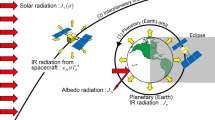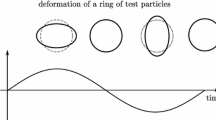Abstract
The threshold values of the annual fluence of atomic oxygen (F AO ≈ 1020 cm−2), as well as the ratios of the energy-flux density of vacuum ultraviolet radiation of the solar spectrum to the flux density of atomic oxygen (Φ ν /Φ AO ≈ 8 × 10−15 mJ) were determined, which are characterized the influence of the synergistic effect on the mass loss of Kapton-H, PM-A, and PM-1E polyimide films, which are spacecraft materials.
Similar content being viewed by others
References
Koontz, S.L., Leger, L.J., Rickman, S.L., et al., Oxygen Interactions with Material III — mission and induced environments, J. Spacecr. Rockets, 1995, vol. 32, no. 3, p. 475.
Milinchuk, V.K., Klinshpont, E.R., Shelukhov, I.P., et al., Degradation of polymer materials on the Mir orbital sattion, Izv. Vyssh. Ucheb. Zav., Yadernaya Energetika, 2002, no. 2, p. 108.
Anan’eva, O.A., Milinchuk, V.K., and Zagorskii, D.L., Investigation of one-sided aluminum films exposed on the Mir orbital station, Khim. Vys. Energ., 2007, vol. 41, no. 6, p. 445.
Allegri, G., Corradi, S., Marchetti, M., et al., On the degradation of polymeric thin films in LEO space environment, Proc. 9th Intern. Symp. on Materials in a Space Environment, Noordwijk, the Netherlands: ESA SP — 540, 2003.
Pippin, H.G., Final report of analysis of Boeing specimens from on the effects of space environment on materials experiment. Appendix B, NASA Langley Research Center, Hampton. VA 23681-2199, 2008, p. 10.
Koontz, S., Leger, L., Albyn, K., and Cross, J., Vacuum ultraviolet radiation / atomic oxygen synergism in materials reactivity, J. Spacecr. Rockets, 1990, vol. 27, no. 3, p. 346.
Shimamura, A. and Miyazaki, E., Investigation into synergistic effects of atomic oxygen and vacuum ultraviolet, J. Spacecr. Rockets, 2009, vol. 46, no. 2, p. 241.
Grossman, E. and Gonzman, I., Space environment effects on polymers in low Earth orbit, Nucl. Instr. Meth. Phys. Res., 2003, vol. B208, p. 48.
Yokota, K., Seikyu, S., Tagawa, M., and Ohmae, N., A quantitative study in synergistic effects of atomic oxygen and ultraviolet regarding polymer erosion in LEO space environment, Proc. 9th Intern. Symp. on Materials in Space Environment, Noordwiijk, ESTEC, 2003, p. 265.
Grossman, E., Gouzman, I., Lempert, G., et al., Assessment of atomic-oxygen flux in low-Earth orbit ground simulation facilities, J. Spacecr. Rockets, 2004, vol. 41, no. 3, p. 356.
Tagawa, M., Atomic oxygen-induced polymer degradation phenomena in simulated LEO space environments: How do polymers react in a complication space environment, Acta Astronaut., 2008, no. 62, p. 203.
Gurevich, A.V. and Shvarburg, A.V., Nelineinaya teoriya rasprostraneniya radiovoln v ionosfere (Nonlinear Theory of Propagation of Radio Waves in the Ionosphere), Moscow: Nauka, 1973.
Akishin, A.I. and Guzhova, S.K., Interaction of ionosphere plasma with materials and equipment of spacecraft, Fiz. Khim. Obrab. Mater., 1993, no. 3, p. 40.
Voitsenya, V.S., Guzhova, S.K., and Titov, V.I., Vozdeistvie nizkotemperaturnoi plazmy i elektromagnitnogo izlucheniya na materialy (Impact of Low Temperature Plasma and Electromagnetic Radiation on Materials), Moscow: Energoatomizdat, 1991.
Nikiforov, A.P., Ternovoi, A.I., Samsonov, P.V., and Skurat, V.E., Problems of studying the mechanism of interaction of vacuum UV-emission and hyper-thermal atomic oxygen (5eV) with polymer materials of spacecraft, Khim. Fiz., 2002, vol. 21, no. 5, p. 73.
Novikov, L.S. and Chernik, V.N., Primenenie plazmennykh uskoritelei v kosmicheskom materialovedenii. Uchebnoe posobie (Application of Plasma Accelerators in Space Materials Science: A Manual), Moscow: Universitetskaya kniga, 2008.
Zimcik, D.G., Wertheimer, M.R., Balmain, K.B., et al., Plasma-deposited protective coating for spacecraft applications, J. Spacecr. Rockets, 1991, vol. 28, no. 6, p. 652.
Chernik, V.N., Naumov, S.F., Demidov, S.A., et al., Studies of polyimide films with protective coating for spacecraft, Perspektivnye Materialy, 2000, no. 6, p. 14.
Pereverzev, E.S., Modeli nakopleniya povrezhdenii v zadachakh dolgovechnosti (Models of Damage Accumulation in Problems of Longevity), Kiev: Naukova Dumka, 1995.
Shuvalov, V.A., Kochubei, G.S., Priimak, A.I., et al., Changes of properties of the materials of solar arrays under the action of atomic oxygen, Kosm. Issled., 2007, vol. 45, no. 4, pp. 314–324. [Cosmic Research, pp. 294–304].
Novikov, L.S., Modern status and prospects of studying the interaction of spacecraft with environment, Model’ kosmosa, Panasyuk, M.I. and Novikov, L.S, Eds., Moscow: KDU, 2007.
ECSS-E-10-04A Standard. Parameters of Space Environment, In action from January 21, Noordwijk: ESTEC, 2000.
Shishatskaya, L.P., Yakovlev, S.A., and Volkova, G.A., Gas discharge lamps for vacuum UV spectral range, Opt. Zh., 1995, no. 7, p. 72.
Verkhovtseva, E.T., Yaremenko, V.I., and Telepnev, V.D., Gas-jet imitator of VUV and USXR radiation of the Sun and impact of its emission on materials, Kosmichna Nauka i Tekhnologiya, 1998, vol. 4, no. 2/3, p. 102.
GOST (State Standard) R 25645.338-96: Polymer Materials for Space Engineering. Requirements to Testing Their Endurance against Impact of Vacuum Ultra Violet Emission. Introduced on March 12, 1996, Moscow.
Novye naukoemkie tekhnologii v tekhnike: Entsiklopediya v 24 t., T. 17. Vozdeistvie kosmicheskoi sredy na materialy i oborudovanie kosmicheskikh apparatov (New Science-Consuming Technologies in Engineering: Encyclopedia in 24 volumes. Vol. 17: Impact of Space Medium on Materials and Equipment of Spacecraft), Kasaev, K.S., Ed., Moscow: ZAO NII “ENTsITEKh”, 2000.
Korn, V.Z. and Shuvalov, V.A., Probe diagnostics of a flow of particles desorbed from a solid body surface by a jet of low-density plasma, Prikl. Mekh. Tekh. Fiz., 1993, no. 5, p. 144.
Kuvaldina, E.V., Lyubimov, V.K., and Rybkin, V.V., Rate constant and probability of interaction of atomic oxygen with polyimide film, Khim. Vys. Energ., 1992, vol. 26, no. 5, p. 475.
Yokota, K., Ikeda, K., Tagawa, M.A., and Okamoto, A., Synergistic effect of vacuum ultraviolet on a atomic oxygen-induced erosion of fluorinated polymer, Proc. 10th Intern. Symp. on Materials in a Space Environment and 8th Intern. Conf. on Protection of Material and Structures in a Space Environment, Nordwijk, 2006, p. 12.
Author information
Authors and Affiliations
Corresponding author
Additional information
Original Russian Text © V.A. Shuvalov, N.I. Pis’mennyi, G.S. Kochubei, N.A. Tokmak, 2014, published in Kosmicheskie Issledovaniya, 2014, Vol. 52, No. 2, pp. 106–112.
Rights and permissions
About this article
Cite this article
Shuvalov, V.A., Pis’mennyi, N.I., Kochubei, G.S. et al. The mass loss of spacecraft polyimide films under the action of atomic oxygen and vacuum ultraviolet radiation. Cosmic Res 52, 99–105 (2014). https://doi.org/10.1134/S0010952514020063
Received:
Published:
Issue Date:
DOI: https://doi.org/10.1134/S0010952514020063




